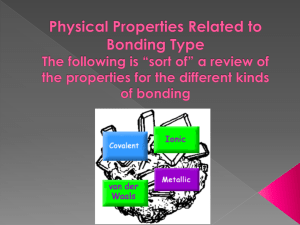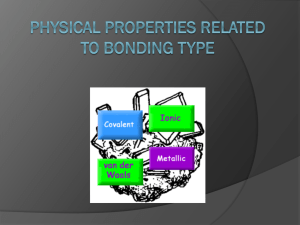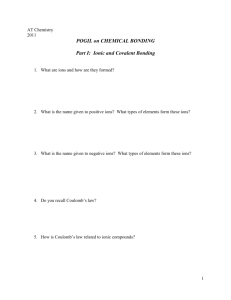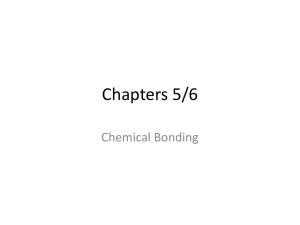A somewhat review of bonding and characteristics
advertisement
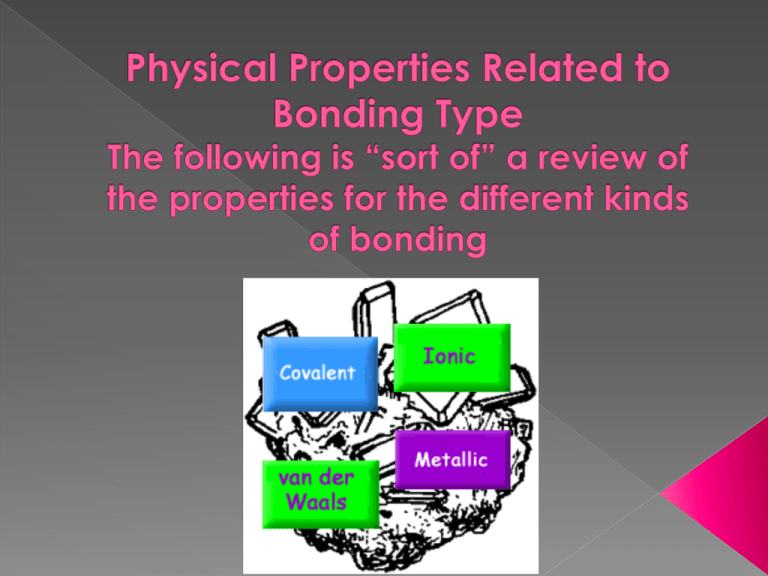
atoms joined by strong covalent bonds insoluble in all solvents (polar or non-polar) high mp and bp e- firmly held in place therefore no conductivity › exception is graphite and graphene that have moving electrons held tight by strong electrostatic forces in between cations and anions non-volatile, high mp, high bp solid at room temp hard and brittle because of lattice/crystalline structure conductivity › non-mobile e- as solid = no › ions move freely when melted = yes › cations and ions separate when dissolved in water = yes soluble in polar solvents like water strong intramolecular forces, weak intermolecular forces, usually liquids or gases at room temp or soft solid › strength of polarity and strength of London forces determine mp and bp greater polarity = higher mp and bp greater van der Waals’ = higher mp and bp often dissolve in nonpolar solvents but not in strong polar solvents like water do not conduct electricity high mp and bp › decreases going down the periodic table harder for cations to attract the sea of electrons › increases going across the periodic table atomic radii becomes smaller, easier to attract the sea of electrons low volatility not soluble in most solvents (polar or non-polar) conduct electricity well because of moving sea of electrons from highest to lowest 1. macromolecular (giant) covalent molecules very strong intermolecular forces hold molecules together diamonds, silicon dioxide, graphite (boils at 4830°C) 2. metallic bonds 3. ionic bonds (cations and anions) 4. hydrogen bonding (strong δ+ or δ-) very strong when H is bonded with NOF (nitrogen, oxygen, or fluorine) 5. dipole - dipole *δ+ or δ-) 6. London forces (weak, temporary δ+ or δ-) generally speaking › the greater the intermolecular force (IMF) between the molecules, the higher the melting point, boiling point, and volatility (evaporate) more electrons help increase the van der Waals’ forces and keep the substance in the these round liquid state shapes do this flat shape allows ittomolecules that can stick together better NOT allow them to stick stick to one remain a liquid at higher temps. to one another better another boiling point increases Exampe: two Lewis structures for the formula C2H6O. Compare the boiling points of the two molecules. hydrogen bonding can occur here which is the strongest type of dipole : dipole intermolecular force ethanol - higher BP only normal dipole : dipole bonding can take place dimethyl ether - lower BP “like dissolves like” › polar substances tend to dissolve in polar solvents (ex. water dissolves ionic compounds) dissociation of salt YouTube (:53) › non-polar substances tend to dissolve in non-polar solvents (ex. alcohol dissolves covalent molecules) giant network covalent molecules and metals do not dissolve in most solvents + – + + – + + + – – + The dipoles of water attract, pushing the oil (with no partial charge) out of the way: attractions win out over the tendency toward randomness. + + + + – + – + + – + – + substances must possess Freely Moving Charged Particles › this occurs in… metals with their “sea of electrons” YouTube (1:05) molten ionic compounds (+ and – ions can move) http://www.dynamicscience.com.au/tester/solutions/ chemistry/bonding/bonding5.htm ionic compounds in aqueous solution (dissolved in water) water pulls apart + and – ions and allows them to move graphite (delocalized electrons move between the layers) Type of Bonding Melting Point Boiling Point Volatilit y Electrical Conductivity Solubility in Nonpolar Solvent Solubilit y in Polar Solvent Nonpolar Low Low High No Yes No Polar varies varies varies No No Yes Hydroge n bonding varies varies varies No No Yes Ionic Bonding high high low Yes (molten or aqueous) No Yes (most) Metallic Bonding high high low Yes No No Covalent varies varies varies No No No Giant Covalent High High Low No (except graphite and graphene) No No
